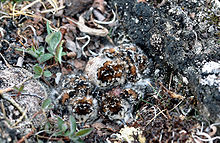Baird sandpipers
| Baird sandpipers | ||||||||||
|---|---|---|---|---|---|---|---|---|---|---|

Baird sandpiper ( Calidris bairdii ) |
||||||||||
| Systematics | ||||||||||
|
||||||||||
| Scientific name | ||||||||||
| Calidris bairdii | ||||||||||
| ( Coues , 1861) |
The Baird sandpiper ( Calidris bairdii ) is a species from the family of snipe birds. The IUCN classifies the Baird sandpiper as harmless ( least concern ). The population is estimated by the IUCN at 300,000 sexually mature individuals.
Appearance
The Baird sandpiper reaches a body length of 14 to 17 centimeters. The wingspan is 40 to 45 centimeters. The weight varies between 35 and 40 grams.
Baird sandpipers in their splendid dress have a dark skull, neck and coat. All feathers have a reddish-brown border. The cheeks are white with a noticeable reddish-brown stripe. The throat is white. The breast is reddish brown with chestnut to brown stripes. The belly and the underside of the tail are white. The feathers on the top of the body are brown with a lighter reddish-brown border. In a simple dress , Baird sandpipers have paler plumage and appear overall gray-brown. The beak is thin, straight and black, the iris is dark brown. The legs and feet are black.
Fledglings have a reddish brown head and chest, but a more striped chest than adult birds. The back looks more scaled due to the wide, light reddish-brown hems. The downy chicks are spotted gray and dark brown on the upper side of the body.
Distribution area
The distribution area of the Baird sandpiper stretches from eastern Russia to western Greenland. Specifically, the breeding areas include the Chukchi Peninsula , Wrangel Island , the North American continent from northern Alaska to Baffin Island and northwest Greenland. During the winter months they stay in South America south of the equator.
The Baird sandpiper prefers the drier tundra as a habitat, where it is often found on the banks of the lake and in the marshland. It is also often seen on the coast.
Way of life
The Baird sandpiper feeds mainly on invertebrates. He picks them up when he wades quickly through shallow water. Occasionally he pauses to poke in the damp underground.
During the winter months it is sociable, but this behavior is less pronounced than with other Calidris species. As a rule, the swarms do not contain more than twenty to thirty individuals. In the breeding area, the males compete for breeding grounds. Males with an established breeding area circle over their territory and call out loudly. He threatens rivals with his head bowed, the beak stretched horizontally forwards and the feathers raised.
Baird sandpipers enter into a monogamous seasonal marriage. The nest is a shallow hollow between pebbles or between tufts of plants. The clutch consists of four eggs. These are pale gray, cream-colored to dark-olive-colored or red-brown with dark or reddish spots. The breeding season is 15 to 20 days. They are fully fledged at 15 to 20 days and independent shortly thereafter. They are sexually mature at the age of a year or two.
supporting documents
literature
- Richard Sale: A Complete Guide to Arctic Wildlife , published by Christopher Helm, London 2006, ISBN 0-7136-7039-8
Web links
- BirdLife factsheet on the Baird sandpiper
- Calidris bairdii inthe IUCN 2013 Red List of Endangered Species . Listed by: BirdLife International, 2012. Retrieved January 14, 2014.
